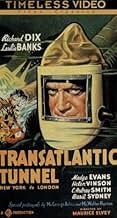IMDb RATING
6.0/10
1.1K
YOUR RATING
A team of international scientists and engineers attempts to build a tunnel under the ocean.A team of international scientists and engineers attempts to build a tunnel under the ocean.A team of international scientists and engineers attempts to build a tunnel under the ocean.
- Awards
- 2 wins total
George Arliss
- Prime Minister of Great Britain
- (as Mr. George Arliss)
Walter Huston
- President of the United States
- (as Mr. Walter Huston)
James Carew
- Jim Barton
- (uncredited)
Pat Fitzpatrick
- Geoffrey - As a young child
- (uncredited)
Jacqueline Giovanni
- Young Girl
- (uncredited)
Helen Haye
- Oil Magnate
- (uncredited)
Bryan Herbert
- American Reporter
- (uncredited)
Dennis Hoey
- Worker
- (uncredited)
Featured reviews
The concept of the movie is very basic: the building of a tunnel connecting the eastern United States with the island of Great Britain. If this were actually possible, it would probably have been done long before now -- but this film is an excellent portrayal of the possibilities. It's quite entertaining for not only fans of old movies, but for history buffs as well -- and even students of transportation should enjoy it!
This science fiction drama from Gaumont had previously been filmed three times in France and Germany. American engineer Richard "Mac" McAllan (Richard Dix) proposes an audacious undertaking: the construction of an underground tunnel beneath the sea bed that will connect London to New York. The massive undertaking involves multiple investors and years of construction time. Mac neglects his wife Ruth (Madge Evans) who seeks comfort with Mac's best friend Frederick (Leslie Banks), while chief investor Lloyd (C. Aubrey Smith) struggles to secure the funds necessary to keep going, while his own daughter Varlia (Helen Vinson) falls in love with Mac.
The science fiction elements are largely kept in the background via set design, the "futuristic" appearance of automobiles, the use of video phones, etc. I would have liked the film more if it had concentrated on the engineering aspects of the construction, or even more on the backroom dealing and politicking of keeping the undertaking afloat. But unfortunately more time is spent on the emotional toil caused by Mac's overwork, and the weak and tedious love triangle. The performances are perfunctory, with the wild-eyed yet still wooden Dix contrasting with Banks, whose facial paralysis often makes it hard to tell what his expression is supposed to convey from scene to scene. I wanted to like this more than I did, but there's still some worthwhile moments among the cliches.
The science fiction elements are largely kept in the background via set design, the "futuristic" appearance of automobiles, the use of video phones, etc. I would have liked the film more if it had concentrated on the engineering aspects of the construction, or even more on the backroom dealing and politicking of keeping the undertaking afloat. But unfortunately more time is spent on the emotional toil caused by Mac's overwork, and the weak and tedious love triangle. The performances are perfunctory, with the wild-eyed yet still wooden Dix contrasting with Banks, whose facial paralysis often makes it hard to tell what his expression is supposed to convey from scene to scene. I wanted to like this more than I did, but there's still some worthwhile moments among the cliches.
Richard McAllan (Richard Dix) is an engineer with an idea. After the construction of a tunnel in the English Chanel, he proposes a tunnel between Britain and America to a group of wealthy industrialists. They agree after some hesitation. This movie follows the long struggle to build the tunnel over many years.
This is 30's sci-fi futurism. I don't really care about the story. I barely care about the construction project. This is like making a drama about the Big Dig in Boston. I do like some of the futurism in this movie. It is a time capsule of this era's sci-fi ideas. That has some entertainment value.
This is 30's sci-fi futurism. I don't really care about the story. I barely care about the construction project. This is like making a drama about the Big Dig in Boston. I do like some of the futurism in this movie. It is a time capsule of this era's sci-fi ideas. That has some entertainment value.
An interesting futuristic film on the premise of building a tunnel under the Atlantic ocean to link Britian and the USA. Richard Dix is his usual stalwart presence as McAllan, an engineer who has in this scenario already created a tunnel under the English Channel, uniting France and England as of 1940, five years in the future from when the film was released.
There are the usual disasters, delays and money problems. The crux of the film though rises from the tragic flaw of hubris (pride), which causes tragedy within the family of McAllan due to his dogged determination to put his job/his vision above all else.
A slight problem results from casting both leading women (Madge Evans and Helen Vinson) since they resemble each other so closely, one has trouble following who is on screen. The best moment is the meeting of the two late in the film and the touching and illuminating scene that results.
Leslie Banks is excellent as the best friend. Henry Oscar is a marvelous villain, self-assured and wickedly serene.
Arliss and Huston have two back to back scenes, beginning at 43 minutes in and one hour and fifteen minutes in. They are quite short and constitute cameos.
The real star here is the art direction of the tunnel itself.
It is kept vague as to exactly how the USA and the UK are going to benefit from this tunnel, however. Seems more problematic than somewhat as opposed to sea or air travel.
It's quite gripping and quite enjoyable. Recommended.
There are the usual disasters, delays and money problems. The crux of the film though rises from the tragic flaw of hubris (pride), which causes tragedy within the family of McAllan due to his dogged determination to put his job/his vision above all else.
A slight problem results from casting both leading women (Madge Evans and Helen Vinson) since they resemble each other so closely, one has trouble following who is on screen. The best moment is the meeting of the two late in the film and the touching and illuminating scene that results.
Leslie Banks is excellent as the best friend. Henry Oscar is a marvelous villain, self-assured and wickedly serene.
Arliss and Huston have two back to back scenes, beginning at 43 minutes in and one hour and fifteen minutes in. They are quite short and constitute cameos.
The real star here is the art direction of the tunnel itself.
It is kept vague as to exactly how the USA and the UK are going to benefit from this tunnel, however. Seems more problematic than somewhat as opposed to sea or air travel.
It's quite gripping and quite enjoyable. Recommended.
Finally saw this movie after many years of eager anticipation only to find myself bored. I have to agree with Maltin's summary of the two-dimensional characterization of the players in this movie. The characters in this movie do nothing more than bicker and argue.
The movie was released in Britain in 1935. A darkening time for Europe was on the horizon with Adolph Hitler's rise to power in Germany. The characters in the movie hint at using the tunnel for uniting the "English" speaking people of the world; not to mention the transportation of armaments to Britain should war break out! Perhaps this movie was supposed to quell the fears of the British by offering an avenue of escapism in the promise of new and revolutionary technology (ie. the Radium Drill!) to avert war.
Never the less the movie does utilize futuristic sets and models that were ahead of their time and still hold their own today. Transportation historians will find this movie interesting. 6.5 out 10.
The movie was released in Britain in 1935. A darkening time for Europe was on the horizon with Adolph Hitler's rise to power in Germany. The characters in the movie hint at using the tunnel for uniting the "English" speaking people of the world; not to mention the transportation of armaments to Britain should war break out! Perhaps this movie was supposed to quell the fears of the British by offering an avenue of escapism in the promise of new and revolutionary technology (ie. the Radium Drill!) to avert war.
Never the less the movie does utilize futuristic sets and models that were ahead of their time and still hold their own today. Transportation historians will find this movie interesting. 6.5 out 10.
Did you know
- TriviaOne of the plot elements that crops up in the movie is a volcanic area that the tunnelers run into about halfway across the Atlantic. This makes sense, as the Mid-Atlantic Ridge is a very active area. The neat part in relation to the movie is that while the existence of a "Ridge" on the seafloor was known at the time, it was not known that it was so active. It wasn't until the Heezen/Ewing/Tharp mapping of the ocean floor in the 1950s that people discovered that Seismic activity and "Seafloor Spreading" due to magma seepage were going on. That was about 20 years after the makers of the film surmised Magma pockets near the Mid-Atlantic.
- GoofsAlthough the story takes place over a period of about twenty years, none of the principal players shows any sign of aging, despite all the ordeals encountered.
- Quotes
Richard 'Mack' McAllan: There are bigger things than money.
Airways Magnate: We don't deal in 'em.
- Crazy creditsAt the end of the opening credits, a card comes up with "Gaumont-British Picture Corpn. Ltd. were fortunate in securing the services of Mr. George Arliss and Mr. Walter Huston for the parts of Prime Minister of Great Britain and President of the United States."
- ConnectionsEdited from Der Tunnel (1933)
Details
- Release date
- Country of origin
- Language
- Also known as
- Transatlantic Tunnel
- Production company
- See more company credits at IMDbPro
- Runtime1 hour 34 minutes
- Color
- Aspect ratio
- 1.37 : 1
Contribute to this page
Suggest an edit or add missing content




































